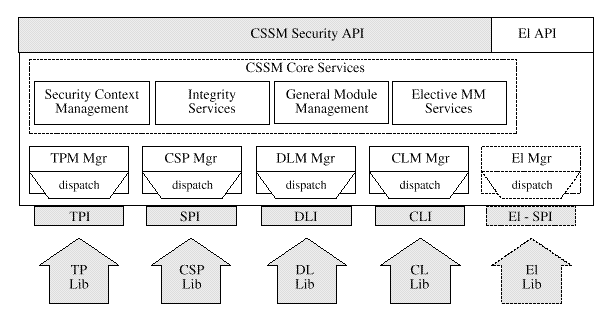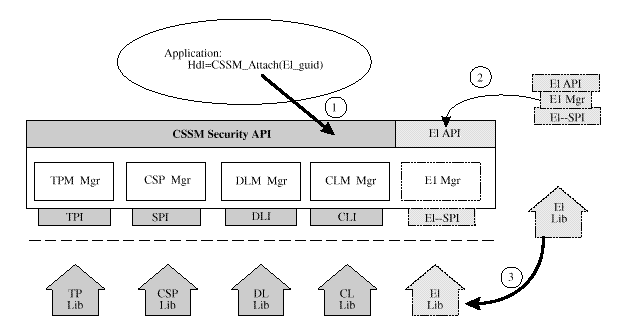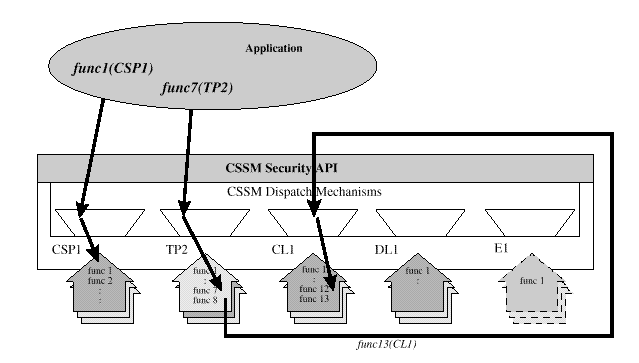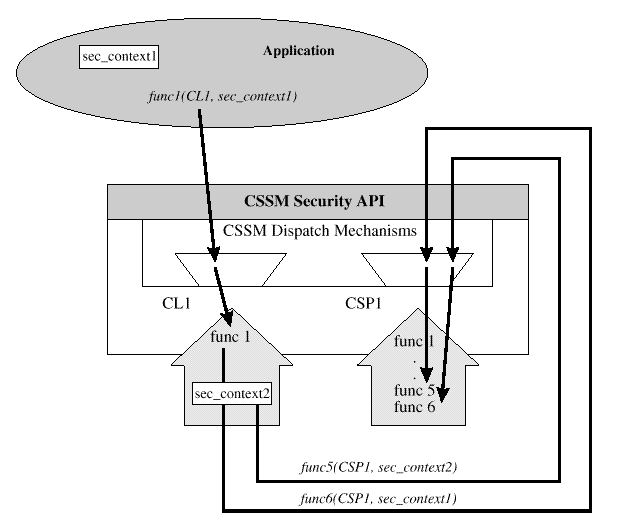Previous section.
Common Security: CDSA and CSSM
Copyright © 1997 The Open Group
Common Security Services Manager
This section provides details on the main infrastructure
component of the CDSA, the Common Security Services Manager
(CSSM).
Overview
The Common Security Services Manager integrates the security
functions required by applications to use cryptographic
service provider modules (or tokens) and certificate
libraries. In particular, it facilitates linking digital
certificates to cryptographic actions and trust protocols.
Tokens and certificate libraries plug into the CSSM as
add-in modules.
Functionally, CSSM provides the services shown in
Services Provided by CSSM
:
-
General module management services-install, dynamically
attach, and dynamically locate module managers and add-in
modules.
-
Elective module managers-dynamically extend the APIs and
security services available to applications implemented to
use those services.
-
Basic module managers-define a minimal set of security
services APIs.
-
Multi-service modules-allow a single add-in service
module to implement services to functionally separate sets
of CSSM APIs.
-
Integrity Services-verify signed credentials to ensure
trusted identification and authorizations.
-
Security context management-aggregate and manage input
and output parameters required when performing cryptographic
operations.
 Figure: Services Provided by CSSM
Figure: Services Provided by CSSM
General Module Management Services
CSSM manages a registry that records
each component's logical name,
attached components in the CSSM environment. CSSM manages a
registry that records information about each installed add-in
module and elective module manager. This information can be
queried by applications, add-in modules, and components of CSSM.
The registry is CSSM's critical information base. CSSM must
protect this information base by controlling access to the
information, (particularly write access), and checking the
integrity of stored values upon retrieval.
The CSSM registry records the logical name of each add-in module
and elective module manager,
the information required to
locate and dynamically initiate the component, and some
minimal meta-data describing the capabilities and services
implemented by the component. An add-in module may or may
not implement all of the APIs defined by CSSM. Unimplemented
functions are registered as null. For extensibility, an
add-in module can implement additional functions outside of the
CSSM-defined API calls. CSSM defines a single
pass-through function, which an add-in module can
overload with multiple custom functions. The meaning and
use of these functions is documented outside of CSSM by the
module vendor.
CSSM APIs allow an application to query the registry of
installed (known) add-in modules to determine the
availability of various security services. Applications must
be able to search the registry by module name and by
features and capabilities. This allows applications to
select specific vendor's modules or to select any module
that provides the desired services. Once an applicable
module is located in the registry information, an
application uses the CSSM attach operation
to load and initiate the module.
For each attach call, CSSM creates a unique attach handle to
identify the logical connection between the application and
the add-in module. CSSM maintains a separate context state for
each attach operation. This enables non-cooperating threads
of execution to maintain their independence,
even though they may share the same process space.
When dynamically loading components, CSSM ensures the
integrity of the expanding system using the CSSM Integrity
Services Library. (The complete set of integrity services
are described in more detail later in this
section.)
When a module is loaded and initiated, it must present a
digitally-signed credential, such as a certificate, to identify its
author and publisher. The signature represents the module
provider's attestation of ownership and a guarantee that the
module conforms to the CSSM specification. CSSM checks the
authenticity of the module's credentials and the integrity of
the module's code before attaching the module to the CSSM
execution environment.
Once the module has been loaded into the CSSM runtime
environment, CSSM exchanges state information with the
application and with the module. This allows CSSM to act as
a broker between the application and a set of add-in
modules. An excellent example of this brokerage service is
CSSM's memory usage model. Often cryptographic operations
and operations on certificates make pre-calculation of
memory block sizes difficult and inefficient. CSSM rectifies
this problem through registration of application memory
allocation callback functions. CSSM and attached add-in
modules use the applications memory functions to create
complex or opaque objects in the application's memory space.
Memory blocks allocated by an add-in module and returned to
the application can be freed by the application using its
chosen free routine.
When an application no longer requires a module's services,
the add-in module can be detached. An application should not
invoke this operation unless all requests to the target
module have been completed. Modules can also be uninstalled.
This operation removes the module name and its associated
attributes from the CSSM's registry. Uninstall must be
performed before a new version of the module is installed in
the CSSM registry.
Elective Module Managers
To ensure long-lived utility of CDSA and CSSM APIs, the
architecture includes several extensibility mechanisms.
Elective module managers is a transparent mechanism
supporting the dynamic addition of new categories of
service. For example, key recovery can be an elective
service. Some applications will use key recovery services
(by explicit invocation) and other applications will not use
it. Audit logs can be an elective service. Applications
wishing to maintain a log can do so, other applications will
not use that facility.
Transparent, Dynamic Attach
Applications are not explicitly aware of module managers.
Applications are aware of instances of add-in modules.
Before requesting services from an add-in service provider
(via CSSM API calls), the application invokes attach
to obtain an instance of the add-in service
provider.
Processing Steps to Attach an Add-In Module
shows the sequence of processing steps.
If the module is of an elective category, then CSSM
transparently attaches the module manager for that category
of service (if that manager is not currently loaded). Once
the manager is loaded, the APIs defined by that module are
available to the application.
The dynamic nature of the elective module manager is
transparent to the add-in module also. This is important. It
means that an add-in module vendor should not need to modify
their module implementation to work with an elective module
manager, versus a basic module manager.
There is at most one module manager for each category of
service loaded in CSSM at any given time. When an elective
module manager is dynamically added to service an
application, that module is a peer of all other module
managers and can cooperate with other managers as
appropriate.
When an attached application detaches from an add-in service
module, CSSM will also unload the associated module manager
if it is not in use by another application.
 Figure: Processing Steps to Attach an Add-In Module
and Load its Elective Module Manager
Figure: Processing Steps to Attach an Add-In Module
and Load its Elective Module Manager
Registering Module Managers
Module managers are installed and registered with CSSM in a
similar manner to add-in modules. CSSM records module
manager information in the CSSM registry. This information
can be queried, but typically only system administration
applications will use registry information about module
managers. For example, a smart installer for an add-in
module may check to see that the corresponding module
manager is also installed on the local system. If not, then
the installer can also install the required module manager.
This does not effect the implementation of the add-in module
itself, just the install program for that module.
State Sharing Among Module Managers
Module managers may be required to share state information
in order to correctly perform their services.
When two or more module managers share state, each
manager must be able to:
-
Inform the other module managers of its presence in the system
-
Request notification of certain states or activities taking
place in the domain of another module manager
-
Gather event information from other module managers
-
Inform the other module managers of its imminent removal
from the system
The other module managers must be able to:
-
Change their behavior based on the presence or non-presence
of another module manager in the system
-
Accept and honor requests from other module managers
for ongoing state and activity information
-
Issue event notifications to other module managers when selected events
occurs
When module managers share state information they
must implement conditional logic to interact with each
other. Different mechanisms can be used to share state information:
-
Invoking known, internal, module manager interfaces
-
Using operating system supported state-sharing mechanisms,
such as shared memory, RPC, event notification, and general
interrupts
-
Using a CSSM supported event notification service
The first two mechanisms depend on platform services outside
of CDSA. Module managers that share state information can
use all of these mechanisms.
CSSM-supported event notifications requires that all module
managers implement and register with CSSM an event
notification entry point. Module managers issue
notifications by invoking a CSSM function, specifying:
-
The source manager
-
The destination manager
-
The event type
-
Notification ID (optional)
-
Data Values (optional)
CSSM delivers the notification to the destination module
manager by invoking the manager's notification entry point.
Typical event types include:
-
Module manager loaded
-
Module manager unloaded
-
Selected Service Request
-
Reply
Module managers that share state information are not
required to use the CSSM event notification mechanism. These
types of events, requests, and notifications can be shared
using the other platform dependent mechanisms. CSSM provides
this simple mechanism specifically for situations where
other platform services are not readily available.
Basic Module Managers
CDSA defines module managers for four basic types of
service:
-
Cryptographic Services Module Manager
-
Certificate Library Module Manager
-
Data Storage Library Module Manager
-
Trust Policy Module Manager
These service categories are considered basic because we
believe that all applications using security services must
use these services. Cryptographic services are the heart of
security services and protocols. Identity, authentication,
and integrity are embodied in digital credentials (such as
certificates). A user's certificates must be persistently
stored for use as long-term credentials. Policies will exist
for how and when the credentials can be used. A
security-aware application that does not use these services is
unusual.
CSSM maintains these module managers in the system at all
times and exports their respective APIs to all applications.
Elective module managers export their APIs to applications
on demand. When active in the CSSM environment, all modules
managers are peers, all are managed uniformly by CSSM, and
all may cooperate and coordinate with each other as required
to perform their tasks.
Dispatching Application Calls for Security Services
Multiple add-in modules of each type may be concurrently
active within the CSSM infrastructure. CSSM module managers
use unique handles to identify and maintain logical
connections between an application and attached service
modules. The handle maintains the state of the connection,
enabling add-in modules to be re-entrant. When an
application invokes the CSSM API, the module manager who
exports the invoked API dispatches the call to the
appropriate module by invoking the corresponding Service
Provider Interface (SPI) supported by the add-in module.
CSSM Dispatches Calls to Selected Add-In Security Modules
shows how managers dispatch function calls to
attached add-in modules.
In
CSSM Dispatches Calls to Selected Add-In Security Modules
,
the application invokes func1 in the
cryptographic module identified by the handle CSP1. A
dispatcher forwards the function call to func1 in the CSP1
module. The application also invokes func7 in the trust
policy module, identified by the handle TP2. A dispatcher
forwards the function call to func7 in the TP2 module. The
implementation of func7 in the TP2 module uses functions
implemented by a certificate library module. The TP2 module
must invoke the certificate library functions via the
dispatching mechanism. To accomplish this, the TP2 module
attaches the certificate library module, obtaining the
handle CL1, and invokes func13 in the certificate library
identified by the handle CL1. A dispatcher forwards the
function call to func13 in the CL1 module.
Calls to the CSSM security API can originate in an
application, in another add-in security module, or in CSSM
itself. The dispatching mechanism forwards all calls
uniformly, regardless of their origin. CSSM ensures access
to CSSM internal structures is serialized through thread
synchronization primitives. If CSSM is implemented as a
shared library then process synchronization primitives are
also employed. Add-in modules need not have multi-threaded
implementations to interoperate with CSSM. Multi-threaded
capabilities are registered with CSSM at module install
time. Access to non-multithreaded add-ins is serialized by
CSSM.
 Figure: CSSM Dispatches Calls to Selected Add-In Security Modules
Figure: CSSM Dispatches Calls to Selected Add-In Security Modules
Modules must be loaded before they can receive function
calls from a dispatcher. An error condition occurs if the
invoked function is not implemented by the selected module.
Integrity Services
CSSM provides a set of integrity services used by CSSM,
module managers, add-in modules, and applications to verify
the integrity of themselves and other components in the CSSM
environment. The dynamic, configurable environment defined
by CDSA and supported by CSSM provides the level of service
and flexibility that applications require. In balance with
the benefits are the increased risk of introducing tampered
components into the environment. To address this, CSSM
provides a set of integrity verification and identity
verification functions. CSSM also requires their use during
each dynamic reconfiguration of the CDSA environment.
CSSM-Enforced Integrity Verification
CDSA checks the integrity of modules as they are dynamically
attached to the system. A bilateral authentication procedure
is designed for two entities to establish trust in the
identity and integrity of each other. When attaching an
add-in module or an elective module manager, CSSM requires that
the attaching party participates in a bilateral procedure to
verify the identity and the integrity of both parties. If
authentication fails, the module is not attached and system
execution is interrupted.
Both parties in the bilateral procedure must have three pieces
of signed credentials:
-
A certificate, signed with a valid, recognized manufacturer
-
A manifest object that aggregates all of the sub-components
and attributes describing the capabilities of the component,
signed with the component's certificate
-
A set of object code modules, signed with the component's
certificate
These credentials are stored in the
local file system and are associated with the component.
CSSM's credentials are also placed
on the system during installation.
The credentials of a dynamic component are placed
on the system when that component is installed with CSSM.
As part of attach processing, CSSM performs the first half
of the bilateral protocol, which proceeds as follows:
-
Locate the component's credentials in the local system
-
Verify the component's certificate and manifest
-
Load the component's object code and verify it signature
-
Determine that the component's initial entry point is
within the checked object code (ensuring secure linkage) and
invoke the verified component
The component completes the authentication procedure as
follows:
-
Self-check the object code signature
-
Locate CSSM's credentials in the local system
-
Verify CSSM's certificate and manifest
-
Verify the object code signature for the loaded CSSM
-
Determine that your return address for CSSM is within the
checked CSSM object code (ensuring secure linkage)
-
Complete attach processing and return to CSSM
When the three credentials verify, it is still necessary to
ensure secure linkage between the components. For the CSSM,
this entails checking that the called address is in fact in
the appropriate code module. For the attaching component,
the return address must be verified to be within the CSSM
calling module. (Even in the case of self-checking, one may
require that the return address be within the module being
checked.)
Linkage checks prevent attacks of the stealth
class, where the object being verified is not the
object that is being used. Also, the checks increase the
difficulty of the man-in-the-middle attack,
where a rogue component will insert itself between two
communicating modules, masquerading itself as the other
component to each component.
Bilateral authentication should also be performed between
applications and CSSM. This requires a manufacturing,
installation and start-up process in which applications
can:
-
Create credentials of the same form as add-in modules and
elective module managers
-
Voluntarily place their credentials
on the local system during application installation
-
Perform their half of the bilateral authentication process
with CSSM
Applications that do not want to implement or cannot
implement the entire bilateral procedure can still benefit
from CSSM integrity services by invoking selected CSSM
integrity functions to:
-
Perform a self-integrity check
-
Check the identity and integrity of CSSM
-
Check the identity and integrity of add-in service modules
Creating Checkable Components
The integrity of a CDSA component is based on verification
of a digital signature on that component. The identity of a
CDSA component is based on verification of a certificate
belonging to that component. To verify a certificate and the
signature of an object module requires that these
credentials be created as part of the manufacturing process.
The enhanced, off-line manufacturing process for all dynamic
components of CDSA is as follows:
-
Issue the component's certificate-this identifies the
component, its author, its publisher and defines the
components capabilities. This certificate must be signed
with a CSSM-recognized certificate owned by the
manufacturer.
-
Uses the certificate to digitally sign all software
routines comprising the component-this tightly binds what
the component is (for example, the software that represents it)
with the identity and authority defined in the certificate.
When manufactured in this manner, the identity and integrity
of the component can be checked.
Applications that wish to present credentials for privileged
services or to be authenticated by CSSM must follow an analogous
manufacturing process.
Verifying Components
CSSM provides signature verification functions to
authenticate the manufacturer as the author and publisher of
the binary object and determine whether or not the CSSM
object was modified after it was signed. Signature
verification requires the use of public keys. Public keys
are public information stored in certificates. They are not
secrets to be protected, but they must be protected from
modification. If replaced with an impostor's public key, an
unauthorized component could pass the integrity check and be
erroneously added to the system.
CSSM must provide verification services without assuming any central
authority as the universal base of trust. Software vendors can
cross-license with other vendors using their digital signature.
These root keys can be provided to CSSM integrity services. CSSM can
perform authentication based on these additional roots of trust only if
the keys are signed and that signature can be verified by CSSM based on
previously known roots of trust. By using certificates to introduce
new vendors, the number of verifiable vendors need not be limited.
The verification tests can be applied as a self-check or to
check another component in the CSSM environment. Periodic,
runtime re-checks can be performed to verify constancy of a
component's integrity. If tampering is detected in any
component, the verification function will interrupt system
execution.
Verification services are available for use on demand by
add-in modules, module managers, applications, and CSSM
itself.
Security Context Services
Security Context Services creates, initializes, and
maintains concurrent security contexts. A security context
is a run-time structure containing security-related
execution parameters, and potentially secrets of an
application process or thread. The structure aggregates the
numerous parameters an application must specify when
requesting a cryptographic operation.
Once cryptographic contexts have been created the
application may freely use those contexts without
CSSM-imposed security checks. Security contexts may contain
secrets, such as encryption keys, passphrases and passphrase
functions. Applications are responsible for protecting these
secrets. Applications desiring maximal protection should use
passphrase callback functions that limit the duration in
which the passphrase is present in the system.
Applications retain handles to each security context used
during execution. The context handle is a required input
parameter to many security service functions. Most
applications instantiate and use multiple security contexts.
Only one context may be passed to a function, but the
application is free to switch among contexts at will, or as
required (even per function call).
A knowledgeable CSP-aware application initializes the security context
structure with values obtained by querying CSSM to obtain
the capabilities of the Cryptographic Services Provider
(CSP) from the CSSM Registry.
An application may create multiple contexts directly or
indirectly. Indirect creation may occur when invoking
layered services, system utilities, trust policy modules,
certificate library modules, or data storage library
modules, that create and use their own appropriate security
context as part of the service they provide to the invoking
application.
shows an example of a hidden security
context. An application creates a context specifying the use
of sec_context1. The application invokes func1 in the
certificate library using sec_context1 as a parameter. The
certificate library performs two calls to the cryptographic
service provider. For the call to func5, the hidden security
context is used. For the call to func6, the application's
security context is passed as a parameter to the CSP.
 Figure: Indirect Creation of a Security Context
Figure: Indirect Creation of a Security Context
These transparent contexts do not concern the application
developer, as they are managed entirely by the layered
service or add-in module that creates them. Each process or
thread that creates a security context is responsible for
explicitly terminating that context.
Security context management provides mechanisms that:
-
Allow an application to use multiple CSPs concurrently
-
Allow an application to concurrently use different
parameters for a single CSP algorithm
-
Support layered implementations in their transparent use of
multiple CSPs or different algorithm parameters for the same
CSP
-
Enable development of re-entrant CSPs
-
Enable development of re-entrant layered services
-
Enable development of re-entrant applications
Why not acquire a nicely bound hard copy?
Click here to return to the publication details or order a copy
of this publication.
You should also read the
legal notice explaining the terms and conditions relating to
the CDSA documentation.




